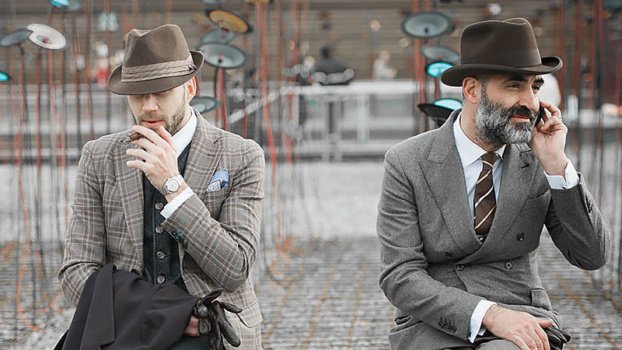
From the 20th Century to Present: The Evolution of the Modern Suit
Until now, men’s suits have seen leaps and bounds in terms of styling. The suits that men wear in the 21st century are not the same as the ones King Charles II or Beau Brummell wore three to four centuries ago. In this blog post, let’s explore the detailed evolutionary changes of suits from the 1900s to today.
Just before the 1900s!
From the mid-1800s to the early 1900s (until the Victorian Era), frock coats were considered dapper. And men chose them as their everyday wear. Soon, these frock coats underwent slight modifications and got split into two—the morning coat and the lounge (night) coat.
The morning coats had tail-like extensions and were considered more formal. On the other hand, lounge coats, as the name implies, were used for informal or casual events. These lounge suits had no tails and looked almost similar to today’s business suits. The only difference lies in the fact that in those days they were predominantly used for informal occasions and today the case is vice versa.
In the first decade of the 20th century
The tailors began giving importance to tiny details of the suit and made a lot of adaptations, like altering the lapel width, jacket length, buttoning point, the type of fabric, etc. With these subtle evolutions, the older men began choosing to wear colorful, contrasting, morning or frock coats. Whereas the country-side men began choosing dark-colored lounge suits for their everyday wear.
The Jazz age
This is one of the most noteworthy and significant periods in the history of the evolution of suits. It was the time when the overall men’s suit styling heavily relied on military uniforms and clothing. This resulted in a jazz age in which suits looked much longer than usual, trousers became cuffed, and men liked more draped-style suits.
More details include the widening of the pants (~11.5 inches), high-raised waistbands, more vibrant colors, patterns, fabrics, etc. Also, pocket squares and collar pins were first introduced in this decade, followed by the double-breasted waistcoat trend.
The Golden age
In this decade, the shoulders of the coats became much wider, the suits became much heavier, the trousers became much tapered at the bottom, and a lot more transformations eventuated to give men a highly masculine and heroic look. Also, in contrast to the so-far-seen close fit to the skin, suits became loose in style and fit, making them baggy. These refinements earned this decade the beautiful title “The Golden Age of Classic Men’s Wear!”
From the fourth to seventh decade
The 1940s, the World War II period, showed signs of minimalism, and the vogue was narrow lapels, trim-cut trousers, and reduced use of fabric (not much draping, double breasts, or waistcoats). The only exception was the zoot suit.
In the post-war period, the 1950s, the slim fit was not popular anymore and tailors began repeating the history with pleated pants and draped coats. Still, the youngsters of that generation rebelled against this suit style. Again, the ‘sack’ suit style came into use. This was followed by the ‘mod’ suit style, which again popularized slim-fit suits.
The 1960s and 1970s were just an extension of the 1950s, with less importance and little transformation.
From the 1980s to the beginning of the 21st century
When compared to the less significant last two decades, the 1980s had outstanding evolutionary changes. Yes, better silhouettes were focused on by giving less padding to the suits. Coincidentally, these were called power suits during the time of capitalism. The lapels were kept wide and the double breasts allowed for reentry. Yet, the 1990s made wavy transformations and had already been forgotten from the history of suits.
The current millennium and chic suits!
Time and again, suits became slim-fit. In other words, they became slimmer and shorter, resembling the mod suit style with higher buttoning points.
Then came the internet and suit designers began tailoring made-to-measure suits. Also, the suits became more casual, more textured, more colored, and a little unstructured—to add a casual touch while keeping them professional and classic.
Which suit style is your pick?After having seen such a long evolution, repetitions in the fit of the suit, adaptations in the details, etc., which suit style impressed you in particular? Let’s tailor one for you now… Reach out to the leading bespoke men’s suit designer—Bucco Cuture!
Recent Posts

